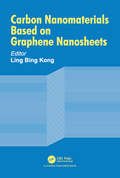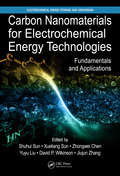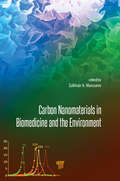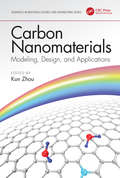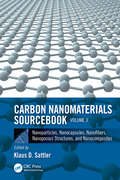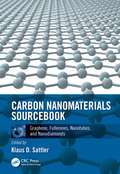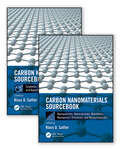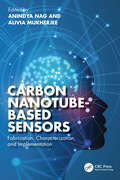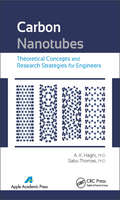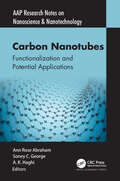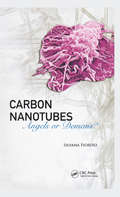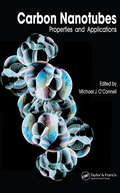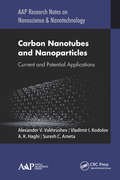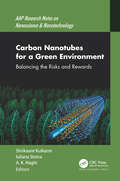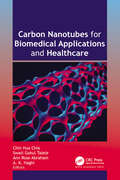- Table View
- List View
Carbon Nanomaterials Based on Graphene Nanosheets
by Ling Bing KongSince the discovery of graphene, it has become one of the most widely and extensively studied materials. This book aims to summarize the progress in synthesis, processing, characterization and applications of a special group of nanocarbon materials derived from graphene or graphene related derivatives by using various strategies in different forms. More specifically, three forms of macrosized materials are presented, i.e., one-dimension or 1D (fibers, wires, yarns, streads, etc.), two-dimension or 2D (films, membranes, papers, sheets, etc.) and three-dimension or 3D (bulk, hydrogels, aerogels, foams, sponges, etc.). Seven chapters are included with the first chapter serving to introduce the concept, definition, and nomenclature of graphene, graphene oxide and their derivatives. The main topics are covered in Chapters 2‒7. Although they have coherent connections, each chapter of them is designed such that they can be studied independently. The target readers of this book include undergraduate students, postgraduate students, researchers, designers, engineers, professors, and program/project managers from the fields of materials science and engineering, applied physics, chemical engineering, biomaterials, materials manufacturing and design, institutes, and research founding agencies.
Carbon Nanomaterials for Electrochemical Energy Technologies: Fundamentals and Applications (Electrochemical Energy Storage and Conversion)
by Shuhui Sun Xueliang Sun Zhongwei Chen Yuyu Liu David P. Wilkinson Jiujun ZhangThis book offers comprehensive coverage of carbon-based nanomaterials and electrochemical energy conversion and storage technologies such as batteries, fuel cells, supercapacitors, and hydrogen generation and storage, as well as the latest material and new technology development. It addresses a variety of topics such as electrochemical processes, materials, components, assembly and manufacturing, degradation mechanisms, challenges, and strategies. With in-depth discussions ranging from electrochemistry fundamentals to engineering components and applied devices, this all-inclusive reference offers a broad view of various carbon nanomaterials and technologies for electrochemical energy conversion and storage devices.
Carbon Nanomaterials for Electrochemical Energy Technologies: Fundamentals and Applications (Electrochemical Energy Storage and Conversion)
by Shuhui Sun Xueliang Sun Zhongwei Chen Yuyu Liu David P. Wilkinson Jiujun ZhangThis book offers comprehensive coverage of carbon-based nanomaterials and electrochemical energy conversion and storage technologies such as batteries, fuel cells, supercapacitors, and hydrogen generation and storage, as well as the latest material and new technology development. It addresses a variety of topics such as electrochemical processes, materials, components, assembly and manufacturing, degradation mechanisms, challenges, and strategies. With in-depth discussions ranging from electrochemistry fundamentals to engineering components and applied devices, this all-inclusive reference offers a broad view of various carbon nanomaterials and technologies for electrochemical energy conversion and storage devices.
Carbon Nanomaterials in Biomedicine and the Environment
by Zulkhair MansurovCarbon nanomaterials possess special physical and chemical properties. As adsorbents, they are widely used for the purification of water and other liquids, recovery of valuable substances from liquid and gaseous media, and oil refining and also in petrochemical, wine, oil and fat, and other industries. They can be used in medicine, both for the creation of hemosorption systems that are capable of performing specific purification of blood and other physiological fluids, including removal of various exo- and endotoxicants, and for the construction of highly effective adsorbed probiotics.The creation of nanostructured carbon-containing materials is one of many rapidly developing research fields and also the theme of this book. The book focuses on the recent developments in the synthesis of nanostructured carbon multifunctional sorbents and covers topics such as fusicoccin compounds as anticancer agents, entero- and vulnerosorption, and blood purification. It will be useful for scientists, chemical industry specialists, professors, and master’s and PhD students of chemical, physical, and biological sciences.
Carbon Nanomaterials in Biomedicine and the Environment
by Zulkhair A. MansurovCarbon nanomaterials possess special physical and chemical properties. As adsorbents, they are widely used for the purification of water and other liquids, recovery of valuable substances from liquid and gaseous media, and oil refining and also in petrochemical, wine, oil and fat, and other industries. They can be used in medicine, both for the creation of hemosorption systems that are capable of performing specific purification of blood and other physiological fluids, including removal of various exo- and endotoxicants, and for the construction of highly effective adsorbed probiotics.The creation of nanostructured carbon-containing materials is one of many rapidly developing research fields and also the theme of this book. The book focuses on the recent developments in the synthesis of nanostructured carbon multifunctional sorbents and covers topics such as fusicoccin compounds as anticancer agents, entero- and vulnerosorption, and blood purification. It will be useful for scientists, chemical industry specialists, professors, and master’s and PhD students of chemical, physical, and biological sciences.
Carbon Nanomaterials: Modeling, Design, and Applications (Advances in Materials Science and Engineering)
by Kun ZhouCarbon Nanomaterials: Modeling, Design, and Applications provides an in-depth review and analysis of the most popular carbon nanomaterials, including fullerenes, carbon nanotubes, graphene and novel carbon nanomaterial-based membranes and thin films, with emphasis on their modeling, design and applications. This book provides basic knowledge of the structures, properties and applications of carbon-based nanomaterials. It illustrates the fundamental structure-property relationships of the materials in both experimental and modeling aspects, offers technical guidance in computational simulation of nanomaterials, and delivers an extensive view on current achievements in research and practice, while presenting new possibilities in the design and usage of carbon nanomaterials. This book is aimed at both undergraduate and graduate students, researchers, designers, professors, and professionals within the fields of materials science and engineering, mechanical engineering, applied physics, and chemical engineering.
Carbon Nanomaterials Sourcebook: Nanoparticles, Nanocapsules, Nanofibers, Nanoporous Structures, and Nanocomposites, Volume II
by Klaus D. SattlerThe Carbon Nanomaterials Sourcebook contains extensive, interdisciplinary coverage of carbon nanomaterials, encompassing the full scope of the field—from physics, chemistry, and materials science to molecular biology, engineering, and medicine—in two comprehensive volumes. Written in a tutorial style, this second volume of the sourcebook: Focuses on nanoparticles, nanocapsules, nanofibers, nanoporous structures, and nanocomposites Describes the fundamental properties, growth mechanisms, and processing of each nanomaterial discussed Explores functionalization for electronic, energy, biomedical, and environmental applications Showcases materials with exceptional properties, synthesis methods, large-scale production techniques, and application prospects Provides the tools necessary for understanding current and future technology developments, including important equations, tables, and graphs Each chapter is dedicated to a different type of carbon nanomaterial and addresses three main areas: formation, properties, and applications. This setup allows for quick and easy search, making the Carbon Nanomaterials Sourcebook: Nanoparticles, Nanocapsules, Nanofibers, Nanoporous Structures, and Nanocomposites a must-have reference for scientists and engineers.
Carbon Nanomaterials Sourcebook: Graphene, Fullerenes, Nanotubes, and Nanodiamonds, Volume I
by Klaus D. SattlerThe Carbon Nanomaterials Sourcebook contains extensive, interdisciplinary coverage of carbon nanomaterials, encompassing the full scope of the field-from physics, chemistry, and materials science to molecular biology, engineering, and medicine-in two comprehensive volumes.Written in a tutorial style, this first volume of the sourcebook:Focuses on g
Carbon Nanomaterials Sourcebook: Nanoparticles, Nanocapsules, Nanofibers, Nanoporous Structures, and Nanocomposites, Volume II
by Klaus D. SattlerThe Carbon Nanomaterials Sourcebook contains extensive, interdisciplinary coverage of carbon nanomaterials, encompassing the full scope of the field—from physics, chemistry, and materials science to molecular biology, engineering, and medicine—in two comprehensive volumes. Written in a tutorial style, this second volume of the sourcebook: Focuses on nanoparticles, nanocapsules, nanofibers, nanoporous structures, and nanocomposites Describes the fundamental properties, growth mechanisms, and processing of each nanomaterial discussed Explores functionalization for electronic, energy, biomedical, and environmental applications Showcases materials with exceptional properties, synthesis methods, large-scale production techniques, and application prospects Provides the tools necessary for understanding current and future technology developments, including important equations, tables, and graphs Each chapter is dedicated to a different type of carbon nanomaterial and addresses three main areas: formation, properties, and applications. This setup allows for quick and easy search, making the Carbon Nanomaterials Sourcebook: Nanoparticles, Nanocapsules, Nanofibers, Nanoporous Structures, and Nanocomposites a must-have reference for scientists and engineers.
Carbon Nanomaterials Sourcebook, Two-Volume Set
by Klaus D. SattlerThis two-volume sourcebook is the most comprehensive reference for carbon nanomaterials, bringing together the physics, chemistry, materials science, molecular biology and engineering of all carbon nanomaterial types that are important in electronics, energy, biomedical and environmental applications. Each chapter addresses the fundamental properties, growth mechanisms, processing and functionalization of a particular nanocarbon. The first volume covers graphene, fullerenes, nanotubes and nanodiamonds. The second volume focuses on nanoparticles, nanocapsules, nanofibers, nanoporous structures and nanocomposites.
Carbon Nanotube-Based Sensors: Fabrication, Characterization, and Implementation
by Anindya Nag Alivia MukherjeeCarbon Nanotube-Based Sensors: Fabrication, Characterization, and Implementation highlights the latest research and developments on carbon nanotubes (CNTs) and their applications in sensors and sensing systems. It offers an overview of CNTs, including their synthesis, functionalization, characterization, and toxicology. It then delves into the fabrication and various applications of CNT-based sensors.FEATURES Defines the significance of different forms of CNT-based sensors synthesized for diverse engineering applications and compares the feasibility of their generation Helps readers evaluate different types of fabrication techniques to generate CNTs and their subsequent sensing Discusses fabrication of low-cost, efficient CNTs-based sensors that can be used for diverse applications and sheds light on synthesis methods for a range of printing techniques Highlights challenges and advances in security-related issues using CNTs-based sensors This book is aimed at researchers in the fields of materials and electrical engineering who are interested in the development of sensor technology for industrial, biomedical, and related applications.
Carbon Nanotube-Based Sensors: Fabrication, Characterization, and Implementation
Carbon Nanotube-Based Sensors: Fabrication, Characterization, and Implementation highlights the latest research and developments on carbon nanotubes (CNTs) and their applications in sensors and sensing systems. It offers an overview of CNTs, including their synthesis, functionalization, characterization, and toxicology. It then delves into the fabrication and various applications of CNT-based sensors.FEATURES Defines the significance of different forms of CNT-based sensors synthesized for diverse engineering applications and compares the feasibility of their generation Helps readers evaluate different types of fabrication techniques to generate CNTs and their subsequent sensing Discusses fabrication of low-cost, efficient CNTs-based sensors that can be used for diverse applications and sheds light on synthesis methods for a range of printing techniques Highlights challenges and advances in security-related issues using CNTs-based sensors This book is aimed at researchers in the fields of materials and electrical engineering who are interested in the development of sensor technology for industrial, biomedical, and related applications.
Carbon Nanotubes: Theoretical Concepts and Research Strategies for Engineers
by A. K. Haghi Sabu ThomasThis book presents the diversity of recent advances in carbon nanotubes from a broad perspective that will be useful for scientists as well as for graduate students and engineers. Presenting leading-edge research in this dynamic field, this volume is an introduction to the physical concepts needed for investigating carbon nanotubes and other one-di
Carbon Nanotubes: Functionalization and Potential Applications (AAP Research Notes on Nanoscience and Nanotechnology)
by Ann Rose Abraham Soney C. George A. K. HaghiThis new book discusses a selection of advanced topics on carbon nanotubes—their extraordinary properties, structure, design, fabrication, development, engineering, functionalization, carbon nanotube enabled nanocomposites, characterization, and, moreover, their utility in many applications. The volume highlights the amazing potential of advanced CNT composites in automotive, aeronautics, spacecrafts, transistors replacing Si electronics, energy, purification, hydrogen storage, tissue regeneration, electrochemical supercapacitors, sensing, biomedical applications, agriculture, energy, and technical applications. The book specifically discusses the applications of carbon nanotubes for a greener environment, as well as applications for biomedical uses, in drug delivery, and in display technology. It also explores the uses of CNTs in the energy and aerospace industries, such as for solar energy conversion, as a lubricant additive for enhancing energy efficiency, and more. Other chapters explore the potential of carbon nanotubes in hydrogen storage and carbon nanotube electronics.
Carbon Nanotubes: Functionalization and Potential Applications (AAP Research Notes on Nanoscience and Nanotechnology)
by Ann Rose Abraham Soney C. George A. K. HaghiThis new book discusses a selection of advanced topics on carbon nanotubes—their extraordinary properties, structure, design, fabrication, development, engineering, functionalization, carbon nanotube enabled nanocomposites, characterization, and, moreover, their utility in many applications. The volume highlights the amazing potential of advanced CNT composites in automotive, aeronautics, spacecrafts, transistors replacing Si electronics, energy, purification, hydrogen storage, tissue regeneration, electrochemical supercapacitors, sensing, biomedical applications, agriculture, energy, and technical applications. The book specifically discusses the applications of carbon nanotubes for a greener environment, as well as applications for biomedical uses, in drug delivery, and in display technology. It also explores the uses of CNTs in the energy and aerospace industries, such as for solar energy conversion, as a lubricant additive for enhancing energy efficiency, and more. Other chapters explore the potential of carbon nanotubes in hydrogen storage and carbon nanotube electronics.
Carbon Nanotubes: Angels or Demons?
by Silvana FioritoThe field of C-nanoparticles toxicity is, at present, fragmented and contradictory, oscillating between enthusiastic raptures and bitter disappointments. This important book presents an overall, unitary view of the carbon nanoparticle world, in which both the positive and negative aspects of these recently discovered nanomaterials are critically de
Carbon Nanotubes: Angels or Demons?
by Silvana FioritoThe field of C-nanoparticles toxicity is, at present, fragmented and contradictory, oscillating between enthusiastic raptures and bitter disappointments. This important book presents an overall, unitary view of the carbon nanoparticle world, in which both the positive and negative aspects of these recently discovered nanomaterials are critically de
Carbon Nanotubes: Properties and Applications
by Michael J. O’ConnellSince their discovery more than a decade ago, carbon nanotubes (CNTs) have held scientists and engineers in captive fascination, seated on the verge of enormous breakthroughs in areas such as medicine, electronics, and materials science, to name but a few. Taking a broad look at CNTs and the tools used to study them, Carbon Nanotubes: Properties and Applications comprises the efforts of leading nanotube researchers led by Michael O’Connell, protégé of the late father of nanotechnology, Richard Smalley. Each chapter is a self-contained treatise on various aspects of CNT synthesis, characterization, modification, and applications. The book opens with a general introduction to the basic characteristics and the history of CNTs, followed by discussions on synthesis methods and the growth of “peapod” structures. Coverage then moves to electronic properties and band structures of single-wall nanotubes (SWNTs), magnetic properties, Raman spectroscopy of electronic and chemical behavior, and electromechanical properties and applications in NEMS (nanoelectromechanical systems). Turning to applications, the final sections of the book explore mechanical properties of SWNTs spun into fibers, sidewall functionalization in composites, and using SWNTs as tips for scanning probe microscopes. Taking a fresh look at this burgeoning field, Carbon Nanotubes: Properties and Applications points the way toward making CNTs commercially viable.
Carbon Nanotubes: Properties and Applications
by Michael J. O’ConnellSince their discovery more than a decade ago, carbon nanotubes (CNTs) have held scientists and engineers in captive fascination, seated on the verge of enormous breakthroughs in areas such as medicine, electronics, and materials science, to name but a few. Taking a broad look at CNTs and the tools used to study them, Carbon Nanotubes: Properties and Applications comprises the efforts of leading nanotube researchers led by Michael O’Connell, protégé of the late father of nanotechnology, Richard Smalley. Each chapter is a self-contained treatise on various aspects of CNT synthesis, characterization, modification, and applications. The book opens with a general introduction to the basic characteristics and the history of CNTs, followed by discussions on synthesis methods and the growth of “peapod” structures. Coverage then moves to electronic properties and band structures of single-wall nanotubes (SWNTs), magnetic properties, Raman spectroscopy of electronic and chemical behavior, and electromechanical properties and applications in NEMS (nanoelectromechanical systems). Turning to applications, the final sections of the book explore mechanical properties of SWNTs spun into fibers, sidewall functionalization in composites, and using SWNTs as tips for scanning probe microscopes. Taking a fresh look at this burgeoning field, Carbon Nanotubes: Properties and Applications points the way toward making CNTs commercially viable.
Carbon Nanotubes and Nanoparticles: Current and Potential Applications (AAP Research Notes on Nanoscience and Nanotechnology)
by Alexander V. Vakhrushev DSc Vladimir I. Kodolov A. K. Haghi Suresh C. AmetaThis new volume looks at significant new research, methodologies, and applications in the fields of carbon nanotubes and nanoparticles. It explores a variety of new developments in advanced carbon nanotubes and nanoparticles along with the tools to characterize and predict their properties and behavior. It introduces and reviews methods that are most frequently encountered in sophisticated nano-scaled materials domains, and helps to bridge the gap between classical analysis and modern real-life applications. A diverse array of topics in the field is addressed that provides many practical insights into nanocomposites and nanomaterials sciences.
Carbon Nanotubes and Nanoparticles: Current and Potential Applications (AAP Research Notes on Nanoscience and Nanotechnology)
by Alexander V. Vakhrushev Vladimir I. Kodolov A. K. Haghi Suresh C. AmetaThis new volume looks at significant new research, methodologies, and applications in the fields of carbon nanotubes and nanoparticles. It explores a variety of new developments in advanced carbon nanotubes and nanoparticles along with the tools to characterize and predict their properties and behavior. It introduces and reviews methods that are most frequently encountered in sophisticated nano-scaled materials domains, and helps to bridge the gap between classical analysis and modern real-life applications. A diverse array of topics in the field is addressed that provides many practical insights into nanocomposites and nanomaterials sciences.
Carbon Nanotubes for a Green Environment: Balancing the Risks and Rewards (AAP Research Notes on Nanoscience and Nanotechnology)
by Shrikaant Kulkarni Iuliana Stoica A. K. HaghiCarbon Nanotubes for a Green Environment: Balancing the Risks and Rewards describes the synthesis, characterization, and unique applications of undoped and doped carbon nanotubes as well as hybrids of them with grapheme or nanocomposites, focusing on green aspects of carbon nanotube applications. The volume shows new approaches used for tapping the potential and promise of key materials in isolation or combined with other materials. The research-oriented chapters highlight a spectrum of applications of carbon nanotubes as novel materials for energy storage as well as for environmental remediation, wastewater treatment, green health care products, and more. Chapters explore the use of carbon nanotubes for remediation methods for wastewater treatment such as by using graphene oxide-carbon nanotube composites and by applying undoped and doped carbon nanotubes for removing contaminates. The book also looks at the application of carbon nanotubes for enhanced oil recovery and for heavy metal separation. Other chapters look at the rheological behavior of carbon nanotubes-based materials and their role in processing for various products, the thermal and electrical transport in carbon nanotubes composites, carbon nanotubes-based composite materials for electromagnetic shielding applications. The biomedical applications of carbon nanotube-based nanomaterials also explored, such as FTIR spectroscopy.
Carbon Nanotubes for a Green Environment: Balancing the Risks and Rewards (AAP Research Notes on Nanoscience and Nanotechnology)
by Shrikaant KulkarniCarbon Nanotubes for a Green Environment: Balancing the Risks and Rewards describes the synthesis, characterization, and unique applications of undoped and doped carbon nanotubes as well as hybrids of them with grapheme or nanocomposites, focusing on green aspects of carbon nanotube applications. The volume shows new approaches used for tapping the potential and promise of key materials in isolation or combined with other materials. The research-oriented chapters highlight a spectrum of applications of carbon nanotubes as novel materials for energy storage as well as for environmental remediation, wastewater treatment, green health care products, and more. Chapters explore the use of carbon nanotubes for remediation methods for wastewater treatment such as by using graphene oxide-carbon nanotube composites and by applying undoped and doped carbon nanotubes for removing contaminates. The book also looks at the application of carbon nanotubes for enhanced oil recovery and for heavy metal separation. Other chapters look at the rheological behavior of carbon nanotubes-based materials and their role in processing for various products, the thermal and electrical transport in carbon nanotubes composites, carbon nanotubes-based composite materials for electromagnetic shielding applications. The biomedical applications of carbon nanotube-based nanomaterials also explored, such as FTIR spectroscopy.
Carbon Nanotubes for Biomedical Applications and Healthcare
Recent advancements and research in nanotechnology, biotechnology, materials engineering the applications of nanomaterial are evolving. Carbon nanotubes (CNT) and CNT-based systems possess unique chemical, physical, and biological properties that make them good candidates in biomedical applications, but they also have some inherent properties that cause great concern about their biosafety. This volume explores the practical applications of carbon nanotubes in biomedical science and human health. It discusses the synthesis, properties, modification, and recent progress of carbon nanotubes and their applications for biosensing, cancer treatment, antibacterial therapy, tissue engineering, targeted drug delivery, and toxicity. It relays the potential and promise of carbon-based nanomaterials for host of applications while also looking at the challenges in synthesis, characterization, and applications of nanomaterials and how to overcome them.
Carbon Nanotubes for Biomedical Applications and Healthcare
by Chin Hua Chia Swati Gokul Talele Ann Rose Abraham A. K. HaghiRecent advancements and research in nanotechnology, biotechnology, materials engineering the applications of nanomaterial are evolving. Carbon nanotubes (CNT) and CNT-based systems possess unique chemical, physical, and biological properties that make them good candidates in biomedical applications, but they also have some inherent properties that cause great concern about their biosafety. This volume explores the practical applications of carbon nanotubes in biomedical science and human health. It discusses the synthesis, properties, modification, and recent progress of carbon nanotubes and their applications for biosensing, cancer treatment, antibacterial therapy, tissue engineering, targeted drug delivery, and toxicity. It relays the potential and promise of carbon-based nanomaterials for host of applications while also looking at the challenges in synthesis, characterization, and applications of nanomaterials and how to overcome them.
